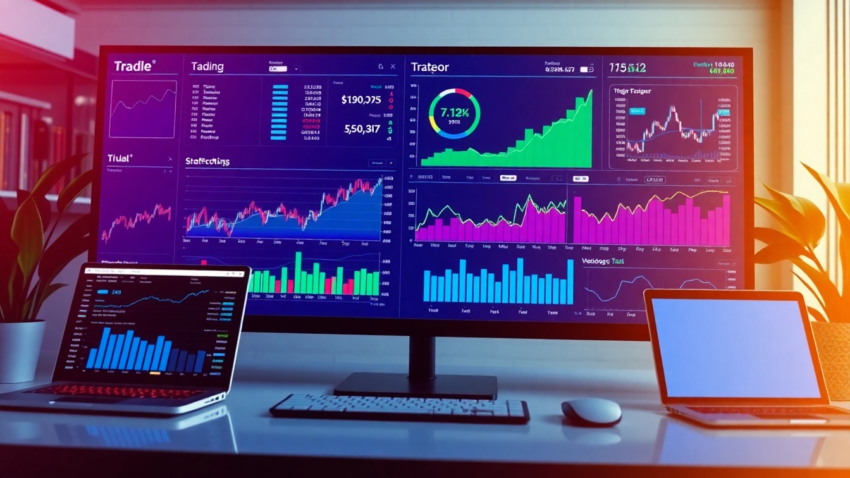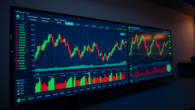
Master the Art of Online Trading with Our Comprehensive Guide
Mastering Online Trading: The Ultimate Guide for Investors Today
Introduction to Online Trading and Its Benefits
In the fast-evolving world of finance, online trading has revolutionized the way individuals and institutions invest in global markets. Unlike traditional methods that rely on brokers and physical platforms, online trading empowers investors with direct, real-time access to a multitude of financial instruments—from stocks and commodities to cryptocurrencies and foreign exchange. This democratization of investing has opened doors for retail investors, making the pursuit of wealth accumulation more accessible and flexible than ever before.
By leveraging robust online trading platforms, investors benefit from instant order executions, comprehensive market data, and a wide array of trading tools at their fingertips. Whether you’re a seasoned trader or a novice exploring your first investments, understanding the nuances of online trading can unlock significant financial opportunities. For a comprehensive roadmap to kickstart your journey, visit our Online Trading Guide.
Understanding the Basics of Online Trading
At its core, online trading involves buying and selling financial assets through internet-based platforms. These platforms connect traders directly with the markets, removing middlemen and reducing transaction costs. Fundamental components include a brokerage account, trading software, and a solid understanding of market mechanics. Traders analyze real-time data, leverage technical and fundamental analysis, and execute strategic orders to capitalize on market fluctuations.
Popular instruments traded online encompass stocks, ETFs, options, futures, forex, cryptocurrencies, and more. Knowledge of order types—such as market orders, limit orders, and stop-loss orders—is essential for managing entry and exit points effectively. Continuous learning about market behaviors and trading psychology enhances decision-making and overall success in online trading.
Advantages Over Traditional Investment Methods
Compared to traditional investing, online trading offers unparalleled immediacy and flexibility. Investors can respond swiftly to market developments, executing trades in milliseconds, which is crucial in volatile environments. The cost structure is typically lower, with many platforms offering commission-free trading or minimal fees compared to traditional brokers, who might charge hefty transaction fees.
Additionally, online trading provides access to advanced analytical tools, educational resources, personalized dashboards, and real-time news updates. This level of transparency and control enables investors to tailor strategies to their risk tolerance and investment objectives, fostering a more proactive and engaging trading experience.
Common Challenges and How to Overcome Them
Despite the numerous benefits, online trading presents challenges such as market volatility, emotional decision-making, and technological issues. Sudden price swings can lead to significant losses if not managed properly. Emotional responses—like panic selling or overleveraging—may impair judgment, emphasizing the importance of disciplined trading plans.
To mitigate these risks, traders should employ risk management techniques like setting stop-loss orders, diversifying portfolios, and maintaining realistic expectations. Additionally, selecting a reliable, secure trading platform with user-friendly features is vital. Regularly updating your knowledge and practicing on demo accounts can build confidence and resilience, helping you navigate turbulent markets effectively.
Setting Up Your Online Trading Platform
Choosing the Right Brokerage Account
Selecting a suitable brokerage account is a critical step towards successful online trading. Consider factors such as licensing and regulation, reputation, fee structures, and user interface. Reputable brokers are registered with financial authorities like FCA, SEC, or ASIC, providing a layer of security and transparency.
Assess your trading goals—whether short-term speculation or long-term investing—and choose a platform that caters to your needs. Look for features like fast execution speeds, margin trading options, and comprehensive research tools. Comparing brokers through reviews and trial accounts can uncover the best fit for your investment style.
Key Features to Look for in Trading Software
An effective trading platform should combine speed, reliability, and versatility. Essential features include advanced charting tools, real-time news feeds, automated trading options, and customizable layouts. Integration with multiple asset classes and APIs enhances flexibility, especially for traders employing algorithmic strategies.
User experience matters; intuitive controls, minimal downtime, and accessible customer support are indicators of high-quality software. Mobile compatibility ensures that traders can stay connected and execute trades from anywhere, maintaining agility in dynamic markets.
Secure and User-Friendly Interface Tips
Security is paramount—look for platforms that employ encryption, two-factor authentication, and regular audits. A clutter-free, logically organized interface reduces errors and enhances efficiency. Educational tutorials, demo accounts, and responsive customer support contribute significantly to a smooth user experience, especially for beginners.
Strategies for Successful Online Trading
Analyzing Market Data Effectively
Data analysis is the backbone of profitable trading. Combining fundamental analysis—evaluating economic indicators, corporate earnings, and geopolitical events—with technical analysis—studying price charts, volume, and patterns—yields actionable insights. Use of indicators like moving averages, RSI, and MACD can identify entry and exit points.
Staying updated with global financial news, central bank announcements, and economic reports helps anticipate market movements. Tools like economic calendars and sentiment analysis platforms are invaluable for proactive decision-making.
Risk Management Techniques
Effective risk management preserves capital and ensures longevity in trading. Techniques include setting appropriate stop-loss and take-profit levels, maintaining position sizes relative to account equity, and diversifying across assets. Using trailing stops can lock in gains while limiting downside, especially in trending markets.
Developing a strict trading plan—defining entry criteria, risk per trade, and exit strategy—and adhering to it reduces impulsive decisions. Regularly reviewing and adjusting your risk parameters based on market conditions enhances resilience.
Implementing Automated Trading Tools
Automation allows traders to execute predefined strategies consistently and swiftly, reducing emotional bias. Platforms offering Expert Advisors (EAs), algorithms, and API integrations enable continuous market participation without constant oversight.
While automation can boost efficiency, it’s crucial to monitor performance, backtest strategies rigorously, and adjust parameters to prevent losses during unexpected market shifts. Combining automated tools with human oversight creates a balanced approach for long-term success.
Optimizing Your Trading Performance
Tracking and Evaluating Your Trades
Maintaining a trading journal—documenting entry and exit points, rationale, and outcomes—provides invaluable feedback for improvement. Analyzing performance metrics such as win-rate, profit factor, and drawdowns helps identify strengths and weaknesses.
Regular review sessions to scrutinize trades should focus on emotional discipline, adherence to the plan, and lessons learned. Utilizing analytics tools offered by trading platforms can streamline this process, fostering continuous development.
Adapting Strategies Based on Trends
Markets are dynamic; successful traders adapt their strategies to evolving conditions. Recognize macroeconomic shifts, technological innovations, and behavioral patterns. Employing flexible trading styles—such as switching between trend-following and mean-reversion—can capitalize on different market phases.
Backtesting alternative strategies using historical data and paper trading helps assess their viability before real-money implementation. Staying open to change and embracing innovation are keys to sustained trading performance.
Using Educational Resources to Improve Skills
Continuous learning through webinars, tutorials, and expert analyses keeps traders ahead of emerging trends. Reading books, participating in forums, and enrolling in courses enhance theoretical knowledge and practical skills.
Many platforms offer demo accounts and simulation tools, enabling risk-free practice. Building a network with experienced traders and mentors accelerates skill development and confidence.
Future Trends and Innovations in Online Trading
Emerging Technologies and AI Integration
Artificial intelligence (AI) and machine learning are transforming online trading by enabling predictive analytics, personalized insights, and faster decision-making. AI algorithms can analyze vast datasets to identify patterns, forecast market movements, and execute trades autonomously.
Platforms integrating AI can offer tailored strategies based on individual risk profiles and preferences, enhancing trading efficiency. Staying abreast of these technological advancements positions traders to leverage the next wave of innovation effectively.
Regulatory Changes and Compliance
The online trading landscape is subject to evolving regulatory frameworks aimed at ensuring transparency, fair trading, and investor protection. Staying compliant requires understanding regional laws, leveraging secure and licensed platforms, and adhering to reporting obligations.
Anticipated regulatory shifts may include stricter Know Your Customer (KYC) protocols, enhanced cybersecurity standards, and disclosures related to algorithmic trading. Vigilance and proactive adaptation help mitigate legal risks and foster trust.
Adapting to Global Market Shifts
Global economic and political developments influence asset prices and trading opportunities. Events like geopolitical tensions, monetary policy adjustments, and technological disruptions demand agility and strategic reassessment.
Developing a macroeconomic awareness and diversifying across asset classes and geographies buffers against localized shocks. Tools such as international news platforms and cross-market analysis are indispensable for informed adjustments.






